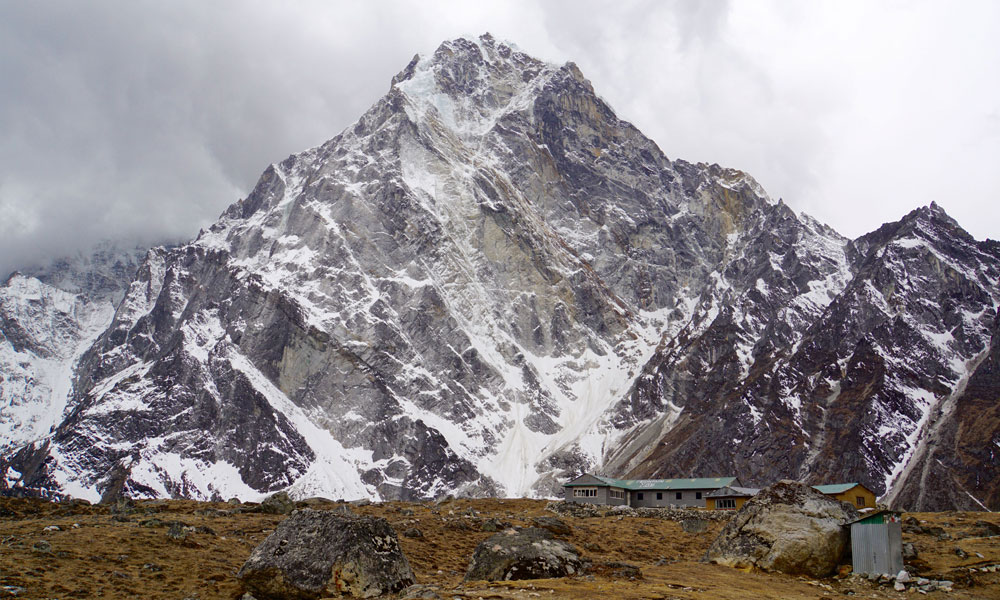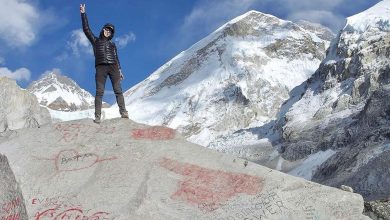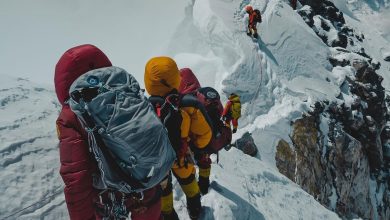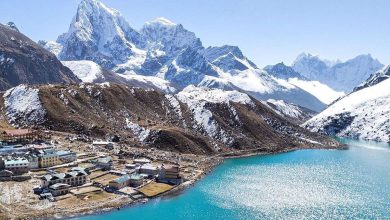Reaching Everest Base Via Gokyo and Cho La Pass
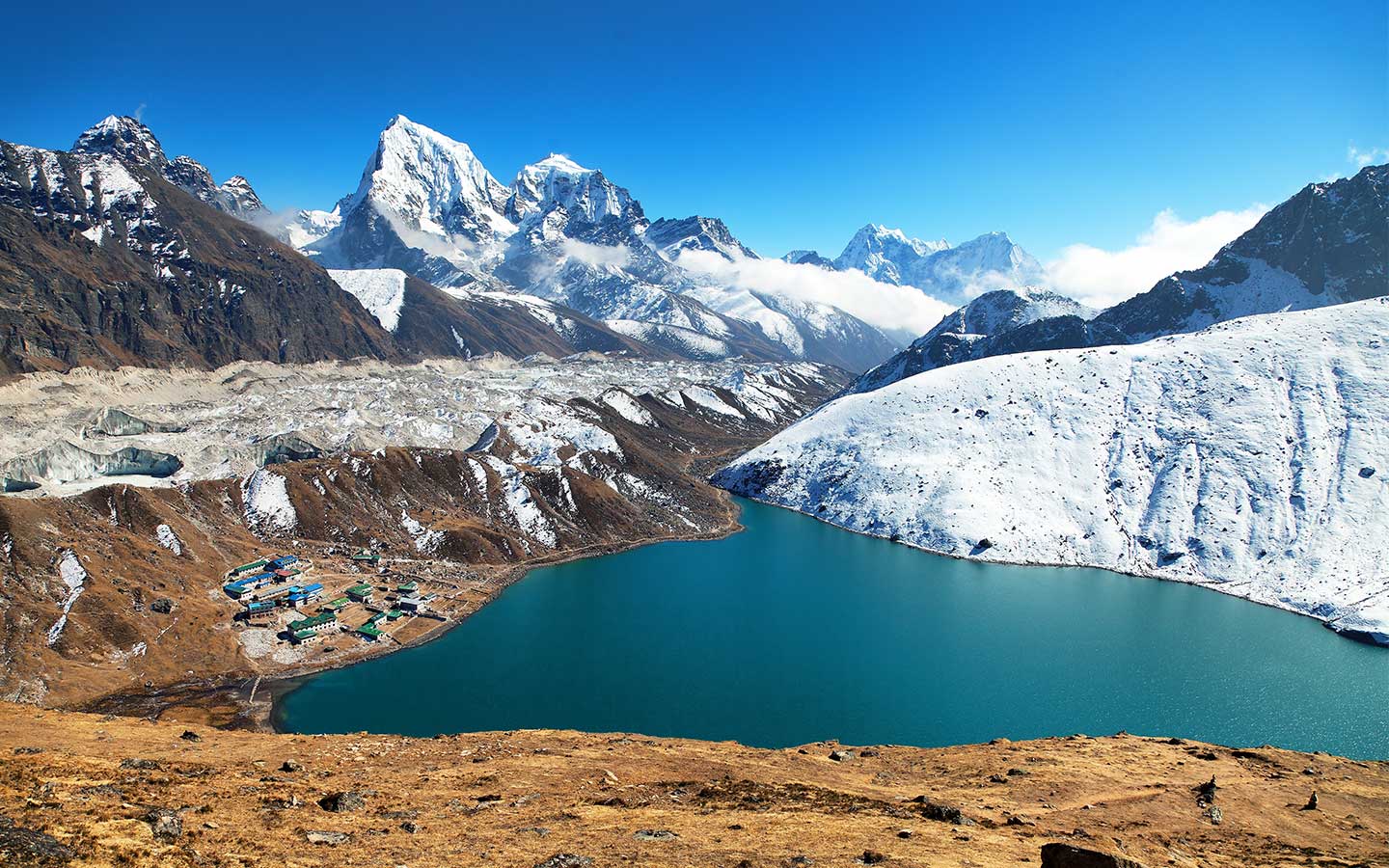
Everest Base Camp Cho La Pass Gokyo Trek is a once-in-a-lifetime adventure in the Khumbu region. This package combines three different destinations of the Everest region into one.
Everest Base Camp and Gokyo Cho La Pass Trek lie in the SoluKhumbu District of Province No. 1. The trekking trails flow inside the beautiful Sagarmatha National Park.
You get to see much beautiful flora and fauna on the trails during your trip. Some are Red pandas, Snow leopards, rhododendrons, Pines, Oaks, Langur, Danphe, and more.
The trek lets you visit two popular destinations: Everest Base Camp and Gokyo Valley, it also crosses over one of the highest passes: Cho La Pass. The EBC Gokyo Pass trails bless you with glorious views of Ama Dablam, Kanchenjunga, Nuptse, Pumori, Everest, and more.
Gokyo Valley is famous for Gokyo lakes and Gokyo Ri, one of the viewpoints. You get to climb Gokyo Ri and explore the Fourth and Fifth lakes during your visit.
Likewise, Everest Base Camp leads you to the foothill of the world’s tallest mountain. The visit lets you hike to Kala Patthar, the best viewpoint of Khumbu, to watch the sunrise.
Moreover, you get to cross Cho La Pass when trekking from Everest Base Camp to Gokyo. The trails offer visitors a marvelous time with lush forests, rich Sherpa culture, natural beauty, and snowy peaks.
When is the best time to visit Everest Base Camp Cho La Pass Gokyo Trek?
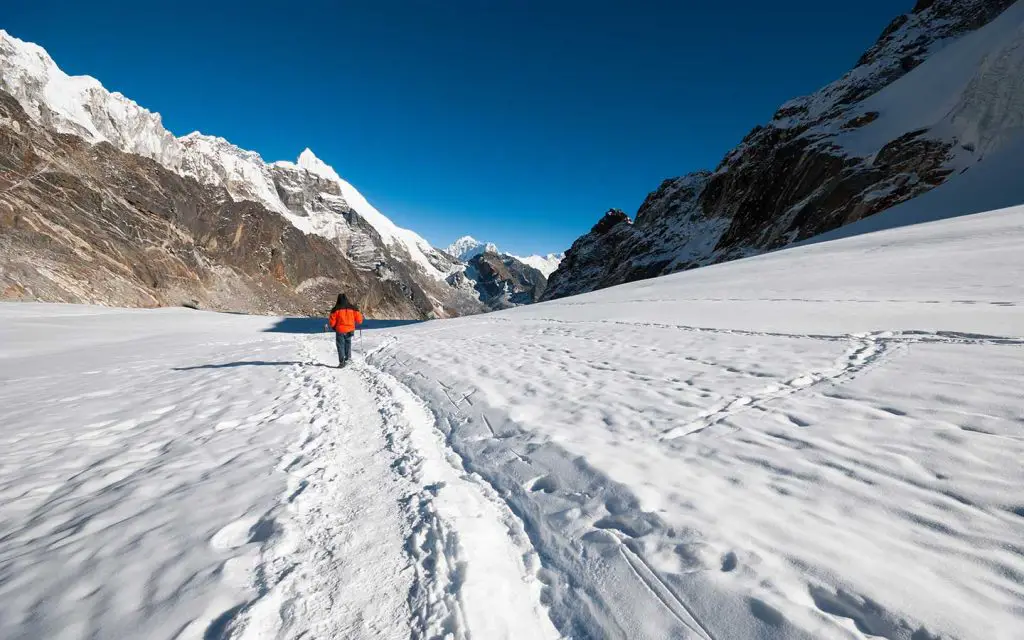
Trek to Everest Base Camp and Gokyo Pass Nepal is doable any month of the year. There are four seasons: spring, autumn, winter, and monsoon, and you can visit the trails any time in the 365 days.
However, some months can be favorable while some might not, and among them, many trekkers consider autumn and spring the best time to visit Everest Base Camp Cho La Pass Trek.
Spring brings a new beginning to nature with it. The lost greenery and new buds bloom around the Himalayas as months enter into this season. March, April, and May are its months. During this time, the weather is great, with clear visibility of the scenarios, while the temperature is right to reach high altitudes.
Autumn begins after the rainy seasons, so the views are best during this time. The monsoon rain washes away all the dirt and pollution, giving nature a fresh look. September, October, and November are its months. The sunny and bright days with mild temperatures make this season perfect for EBC and Gokyo Cho La Pass trek.
Is Trek to Everest Base Camp Cho La Pass Gokyo Hard?
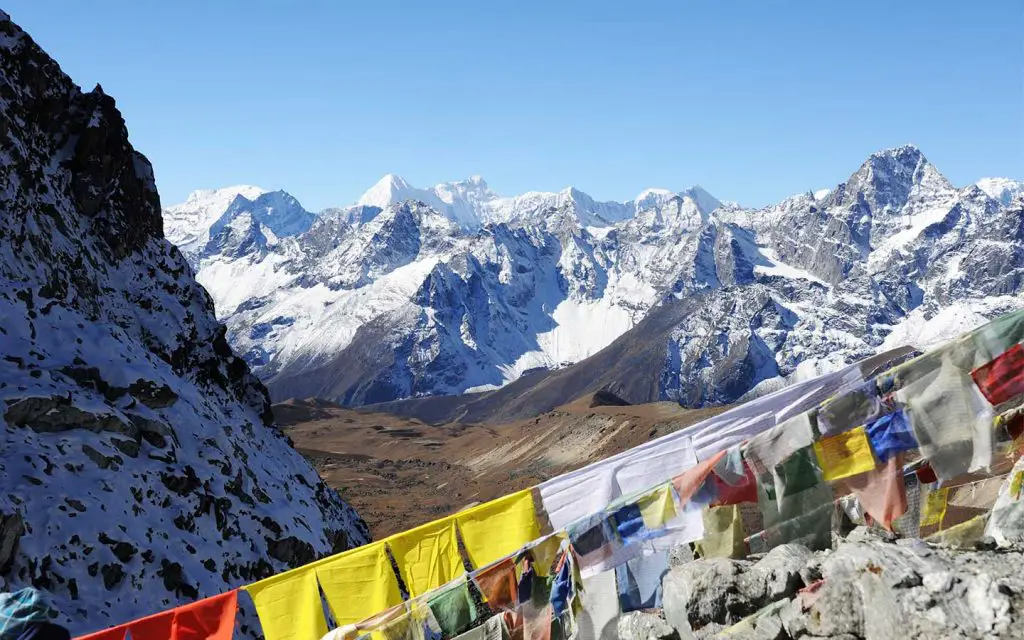
Trek to Everest Base Camp and Gokyo Pass Nepal are moderate to hard-level difficult. The trails are open for all trekkers to visit, but having a sound body and mind is necessary.
The standard walking duration and distance is 5 to 6 hours while covering 15 km each day. However, walking more hours and covering more distance can put stress on your body.
Walking the Everest Base Camp Cho La Pass Gokyo trails will be harsher for beginners. It is because you must climb and descend the uneven topography daily.
Traveling to the mountains is exciting and adventurous but comes with several difficulties. Some of them are Weather and temperature, altitude sickness, accommodation, etc.
The 12 Days Everest Base Camp Cho La Pass Gokyo trek takes you above 4500 m elevation for most of the journey. So, the risk of altitude sickness is high for some visitors.
Likewise, weather and temperature play a major role because traveling during bad climatic conditions increases the chance of delays and cancellations. Also, the view of nature will be unclear, creating disappointment for nature lovers.
Overall, the Trek to Everest Gokyo Cho La Pass is not an easy journey, so you need to be well-prepared before the trek.
Food and Accommodation during Everest Base Camp Cho La Pass Gokyo Trek
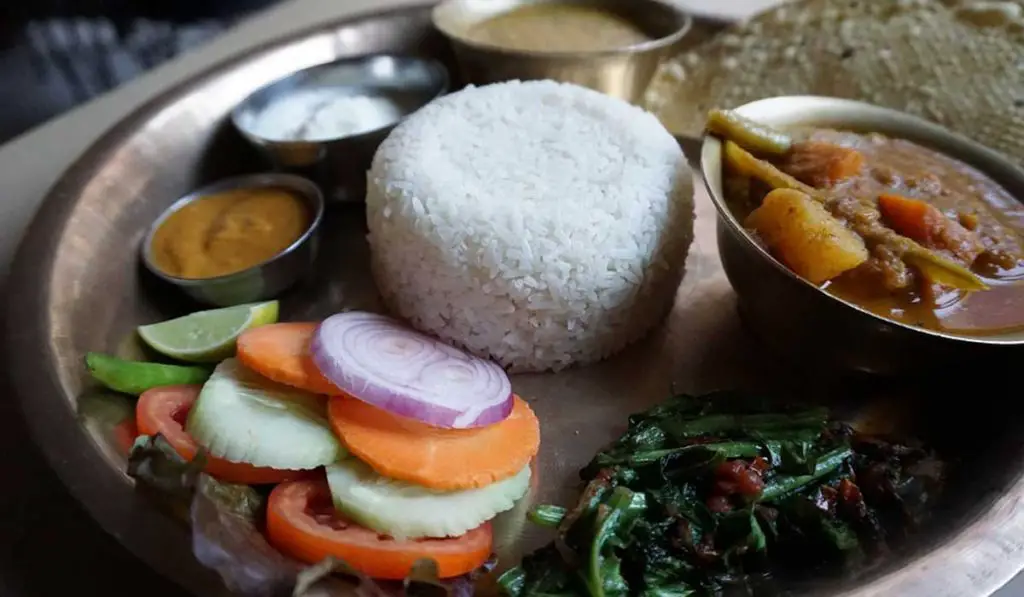
The trails of Everest Base Camp Cho La Pass Gokyo Trek mostly offer tea houses for a stay. There are no three-star or five-star hotels available during the trekking journey.
You will find simple tea houses or lodges that provide very fundamental amenities. Each room has two beds with pillows, mattresses, and blankets, while in some places, they also have cupboards and chairs.
Similarly, you do not have many privileges on toilets as well. You might find rooms with an attached toilet only in lower areas because in higher places, common bathrooms are located outside the inn. Also, the restrooms are Asian-squat-style ones.
Likewise, the trek is remote, so you won’t find many Western cuisines on the menu. However, the breakfast and lunch menu changes daily, while dinner remains the same.
For breakfast, you get to eat toast with jam or peanut butter, boiled egg, aloo paratha, muesli, oats, cornflakes, scrambled egg, and many more. The menu offers you noodles, roti with aloo, momo, chowmein, thukpa, etc. for lunch.
Moreover, you will only eat the staple food of Nepal for dinner. Each day you have a Thakali Khana set that includes: rice, lentils, curry, spinach, pickles, and other side dishes.
Permits required for Everest Base Camp Cho La Pass Gokyo Trek
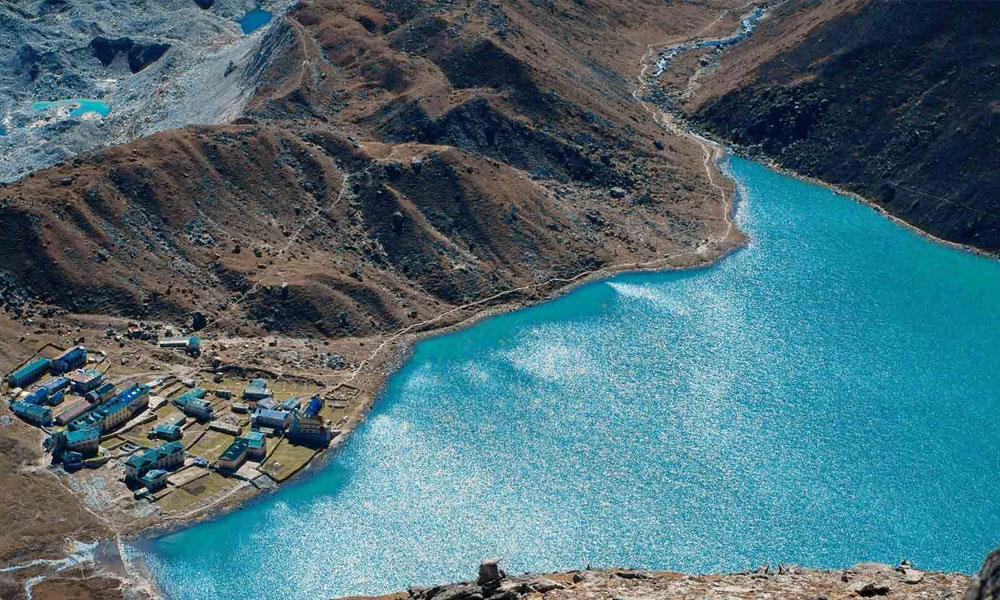
Like any other trekking destination, Everest Base Camp Cho La Pass Gokyo Trek requires a permit. You need two different permits: the Sagarmatha National Park entry permit and the Khumbu Pasang Lhamu Rural Municipality permit for this tour.
Sagarmatha National Park permit allows you to walk and explore inside this Himalayan park. The permit fee is US$ 30 (NPR 3000) for foreigners and US$15 (NPR 1500). You can obtain the tickets from Nepal Tourism Board in Kathmandu or Monjo.
Khumbu Pasang Lhamu Rural Municipality permit allows you to visit and explore the remote places of the Khumbu district. The permit fee is US$ 20 and can be obtained from Lukla or Monjo. It is not available in Kathmandu.
You may also like:
Travel Insurance
Getting travel Insurance is compulsory before starting your trek in the mountains. With insurance, you can explore freely without stress from high medical bills, evacuation, and more.
Everest Base Camp Cho La Pass Gokyo Trek involves traveling to remote regions of Khumbu. The trek itself is not dangerous, but it poses various risks, so you need to consider those factors when choosing your insurance.
Even the smallest injuries, like sprained ankles can be your biggest nightmare. So, choosing the correct insurance policy that covers trek above 5000 m is necessary.
Your insurance should handle your medical bills, theft of luggage, and emergency helicopter evacuation from the mountains.
EBC via Gokyo Lake and Cho La Pass Highlights
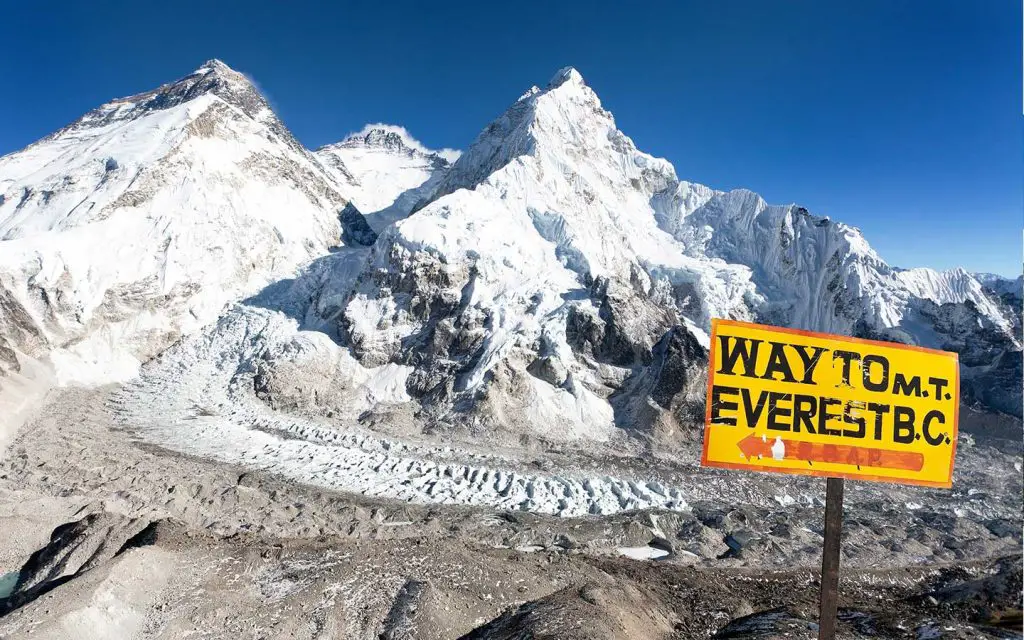
- Sensational view of the dramatic landscapes, snow-capped peaks, and pristine lakes
- Cross one of the high passes, Cho La Pass
- Explore Everest Base Camp, and Gokyo Lake
- View various mountains like Everest, Cho Oyu, Makalu, Ama Dablam, Lhotse, Nuptse, etc.
- Visit Chukkung valley, the gateway to Island Peak
- Enjoy the friendly and warm hospitality of high landers
- Summit Kala Patthar and Gokyo Ri viewpoints for sunrise view
- Explore the Sagarmatha National Park
Which Path Do We Follow to Reach Everest Base Camp?
Day 1: Kathmandu to Lukla (2860 m/ 9383 ft) and Trek to Phakding (2610 m/ 8562 ft)
Flight duration: 25 to 30 minutes
Trekking duration: 3 to 4 hours
Trekking distance: 6.2 km/ 3.7 miles
Overnight at Phakding
You leave Kathmandu at the crack of dawn to fly to Lukla, so wake up early and get ready before your guide arrives to pick you up. After meeting you at the lobby, they drive you to the airport to complete the check-in procedure.
Then, you board the flight and glide towards Lukla while enjoying the miraculous view of surging landscapes, boundless meadows, clifftops, and local farms up until then.
After flying over the lofty hills and traditional villages for half an hour or so, you reach the exquisite town of Lukla. You meet up with the rest of the crew and introduce yourself over breakfast.
After a full tummy, you begin your Everest Base Camp Cho La Pass Trek by walking to Phakding. You head north of the town and start descending the trails to the Khumbu Pasang Lhamu Rural Municipality office.
From here, you purchase the permits and keep descending to the bank of the Dudh Koshi River. Then, you steadily continue walking through the forest of pines and past old mani walls to reach Ghat.
The trails from here onwards have several small ups and downs, but the final push is steep that opens to Phakding. You have your lunch here and head out to explore the lovely village.
Phakding is bigger than Lukla, with lodges, bars, shops, homes, and restaurants lined on the streets.
Day 2: Trek to Namche Bazaar (3440 m/ 11286 ft)
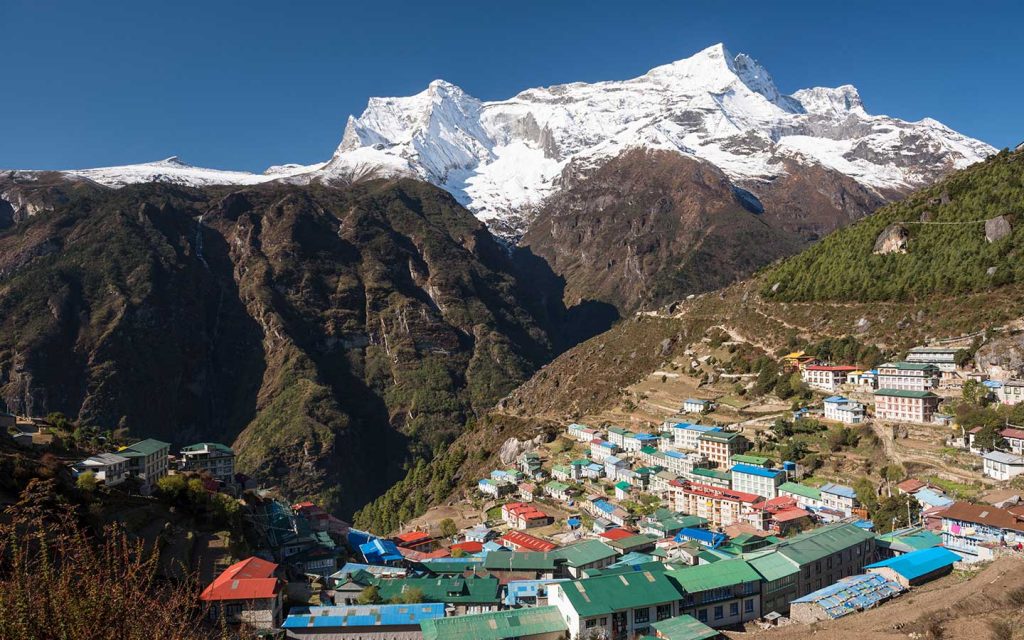
Trekking duration: 7 to 8 hours
Trekking distance: 7.4 km
Overnight at Namche Bazaar
Today’s trek is gruesome as you roughly cover 1200 m altitude. After breakfast, the day starts by crossing a stream using a suspension bridge, then following the dusty trail along the Dudh Koshi River.
You can see the colorful rhododendron blooming and cascading waterfall en route. The trails then pass you through stone stairs and make several ascents, and descent through some dusty routes.
After walking for hours, you arrive at Jorsale and have lunch. This village is also the entry point for Sagarmatha National Park. So, after fueling your body, you hit the trails by ascending them for some time and come across another suspension bridge.
You cross over it and hike uphill into the beautiful forest of pines and oaks. After an hour, you reach the famous Tenzing-Hillary suspension bridge, the longest and highest bridge in the Everest region.
Crossing over the bridge, you rest on the trails and have your lunch before climbing the rugged uphill to Namche Bazaar. The beautiful mountains welcome you to the town from the backdrop.
Day 3: Acclimatization at Namche
After a long trekking journey, you now acclimatize at Namche Bazaar. This day is quite fun as you explore and visit the nearby villages and viewpoints.
You wake up early and walk uphill from the town to a big rock that shows you the beautiful view of Namche and Mt Kongde Ri on its backdrop. From there, you keep hiking up the trail while enjoying the Himalayan view to Syangboche airstrip.
From Syangboche, you walk north and reach a barren meadow. Then, continuing the climb, you arrive at Everest View Hotel. You visit the Hotel and have breakfast here while viewing the various mountains.
Afterward, you head down and go to Khumjung village to visit its monastery. This beautiful cell has several Buddha statues and a Yeti skull.
After exploring the village, you follow the trails back to Namche and have lunch. You should roam the town during the evening when it will be bustling with travelers.
Day 4: Trek to Tengboche (3790 m/ 12434 ft)
Trekking duration: 5 to 6 hours
Trekking distance: 5.9 km
Overnight at Namche
After back-to-back nights in Namche, you head to Tengboche after breakfast today. The trek begins by climbing uphill with stone steps until you reach the flat route.
Then continuing the walk through the unending ridgeline, you get to see the panoramic view of bewitching peaks lining with others. Walking further, you pass attractive chorten with hanging prayer flags before reaching Sansa.
Sansa is the junction that separates the trail between Gokyo and EBC. You follow the route that leads to Everest Base Camp by making a sharp dip to Pungi Thanga.
Reaching here, you have lunch and later cross the Dudh Koshi River using a suspension bridge and arrive at a checkpoint. From there, you pass several prayer wheels and ascend steeply to Tengboche.
Tengboche is vast grazing land with a beautiful monastery and a few tea houses. You visit the amazing monastery and watch the incredible sunset with panoramic mountain ranges on its backdrop.
Day 5: Trek to Dingboche (4350 m/ 14461 ft)
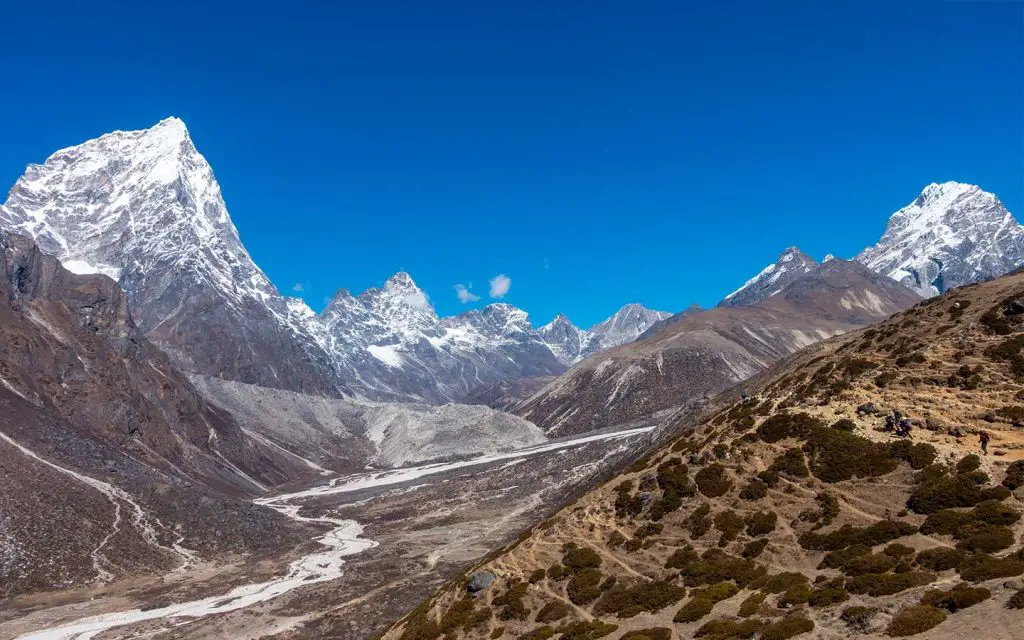
Trekking duration: 6 to 7 hours
Trekking distance: 9.1 km
Overnight at Dingboche
After breakfast, you descend downhill through the dusty forested trails to Pangboche. From here, you move ahead and climb the routes enjoying the beautiful Himalayan views.
After walking for some time, you come across a river and cross it only to make another climb through the enchanted forest of rhododendron. You keep moving ahead and reach a vantage point that shows you the exotic sight of Mount Ama Dablam.
After the tough climb, the heavenly view refreshes you, so you have lunch here. Then gently ascending the trails for another half an hour, you arrive at Dingboche.
Dingboche is more beautiful compared to Tengboche, that only had a monastery and a few lodges. It is a big sustaining settlement above 4000 m altitude surrounded by giant mountains and arid land.
Day 6: Day trip to Chhukung Valley (4730 m/ 15518 ft) and back to Dingboche
Hike duration: 2 to 3 hours
Hike distance: 3.1 km
Overnight at Dingboche
Your second acclimatization is here at Dingboche. These acclimatizations are done to help your body adapt to the rising altitude. It is necessary to have rest days when trekking in higher elevations due to the ratio of oxygen levels in the air.
There are several places to visit during your acclimatization in Dingboche, so we will explore the Chukkung Valley. After breakfast, you begin your hike following the trails alongside the river and down the valley.
You pass through small settlements moving in the sandy and rocky paths while enjoying the marvelous views. The further you walk in the trails, the closer Lhotse, Nuptse, and Ama Dablam get.
You continue walking along the river’s bank to reach Chukkung Valley. This small village is the gateway to Island Peak and Kongma La Pass. You explore around this place, then have your lunch and head back to Dingboche.
Day 7: Trek to Lobuche (4950 m/ 16240 ft)
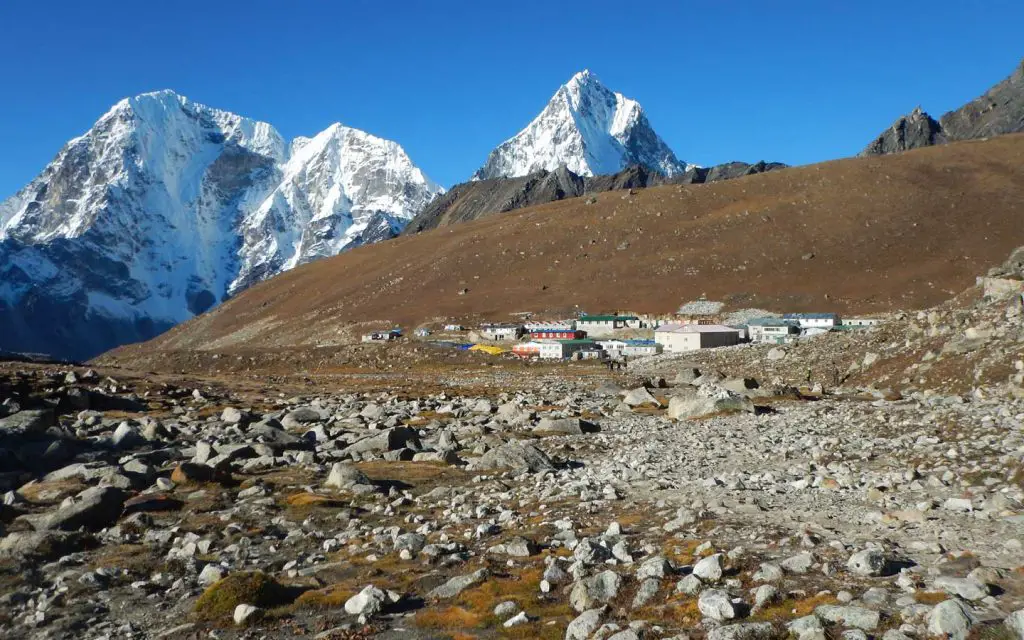
Trekking duration: 5 to 6 hours
Trekking distance: 6.6 km
Overnight at Lobuche
The higher you climb in the elevation, the more views you get to see. After a warm breakfast, you pack your things and head to Lobuche leaving the village behind.
As you walk out, you get to see the two peaks Tabuchi and Arakam Tse on the left. Enjoying the view, you slowly trek up surrounding yourself with hills and landscapes till Thukla.
You have your lunch here and later resume the journey after a full stomach. The trails are steepest in this part as you have to climb up to Dughla Pass at 4830 m. Arriving at the top, a memorial park established for travelers who attempt to climb Everest comes to your sight.
From there, you keep ascending the routes until you reach the glacial moraine of the Khumbu Glacier. You get to see Kala Patthar at a distance from this point, and looking at the sight, you slowly make your way to Lobuche.
Lobuche is a tiny yet beautiful settlement with comfortable tea houses and lodges. You can stroll around the valley and enjoy delicious hot food.
Day 8: Trek to Everest Base Camp (5360 m/ 17598 ft), back to Gorak Shep (5140 m/ 16863 ft)
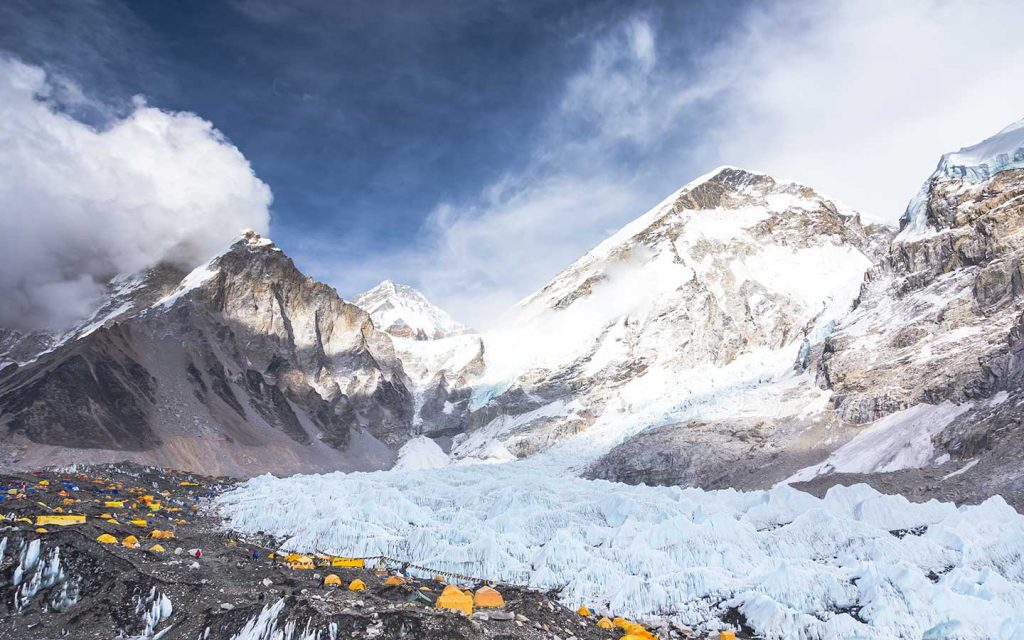
Overall Trekking duration: 5 to 6 hours
The trekking distance to EBC: 3.5 km
Overnight at Gorak Shep
Finally, the day has arrived when you visit the first major highlights of this Everest Base Camp Cho La Pass Gokyo Trek. Today, you trek from Lobuche to Gorak Shep and hike to EBC.
After breakfast, you begin by trekking through the flat land and gradually making your climb in the trials. The stunning view of landscapes and white peaks accompany you along the way.
Leaving Lobuche far behind, you climb along the Khumbu glacier and over the mass of its rugged sediments. The walk is not sharp, but it will be overwhelming due to the excitement.
After a tough hike of many hours, you arrive at Gorakshep. You leave your things in the tea houses, have lunch, and begin hiking towards Everest Base Camp.
Walk slowly while making gradual climbs through the rugged and rocky terrains. You hike for more than an hour to reach the base of Mount Everest. Arriving at your destination will feel like a dream come true.
The base camp offers many marvelous scenarios and one of them is Mount Everest standing tall above you. You click pictures and make memories before retracing your steps back to Gorakshep.
Day 9: Early morning to Kala Patthar (5644 m/ 18520 ft) then trek to Dzonglha (4830 m/ 15850 ft)
Hike duration: 2 to 3 hours
Trekking duration: 5 to 6 hours
Trekking distance: 11.5 km
Overnight at Dzongkha
Today, you climb Kala Patthar to enjoy the beautiful sunrise view from there. So, wake up early in the darkness and make you ascend through the trails to the summit.
The sunrise view looks enchanting as it rises from behind the peaks shining its rays over the valley. This viewpoint also gives a close-up view of Mount Everest along with other peaks.
After enjoying the view, you head back to Gorak Shep following the same way. Later, you have your warm breakfast, then pack your bags and head to your next destination.
The journey is yet not over, you have just finished the first half of it. Now, you trek down to Dzonglha by taking the rough trails with rocks and boulders while losing some elevation.
After a swift descent, you follow the steep, narrow trails for some hour and arrive at Dzonglha. It is a beautiful village surrounded by stunning views of Lhotse, Nuptse, and Cho Oyu.
Day 10: Cross the Cho La Pass (5420 m/ 17782 ft) then trek down to Tagnag (4695 m/ 15403 ft)
Trekking duration: 7 to 8 hours
Overnight at Tagnag
You will climb a high pass today, so to avoid the strong afternoon winds in the summit the trek begins before sunrise. You leave Dzonglha early after a warm breakfast and pass some crevasses.
Then slowly climb up through the steep trails and reach a mountain ridge, where you see the beautiful sunrise. Moving ahead the topography switches to an icy path, so you gradually make the ascend using gaiters, crampons, and ropes.
After walking uphill for a few hours or so, you finally reach the summit of Cho La pass. The trek was tough and challenging, but the wonderful visit from above will be worth it.
There are no settlements near Cho La pass, it is only surrounded by majestic mountains, green hills, and glacial lakes. After clicking some pictures, you trek down towards your destination while rejoicing the beautiful scenarios.
You slowly descend the trails from another side via the stony path to Phedi. You stop here for your lunch and later continue to walk downhill until you reach Tagnag.
Tagnag is a small village with a few lodges and tea shops that offer you a glimpse of Machhermo peak and Cho Oyu.
Day 11: Trek to Gokyo (4800 m/ 15748 ft) then visit fifth lake (4980 m/ 16338 ft) and back to Gokyo
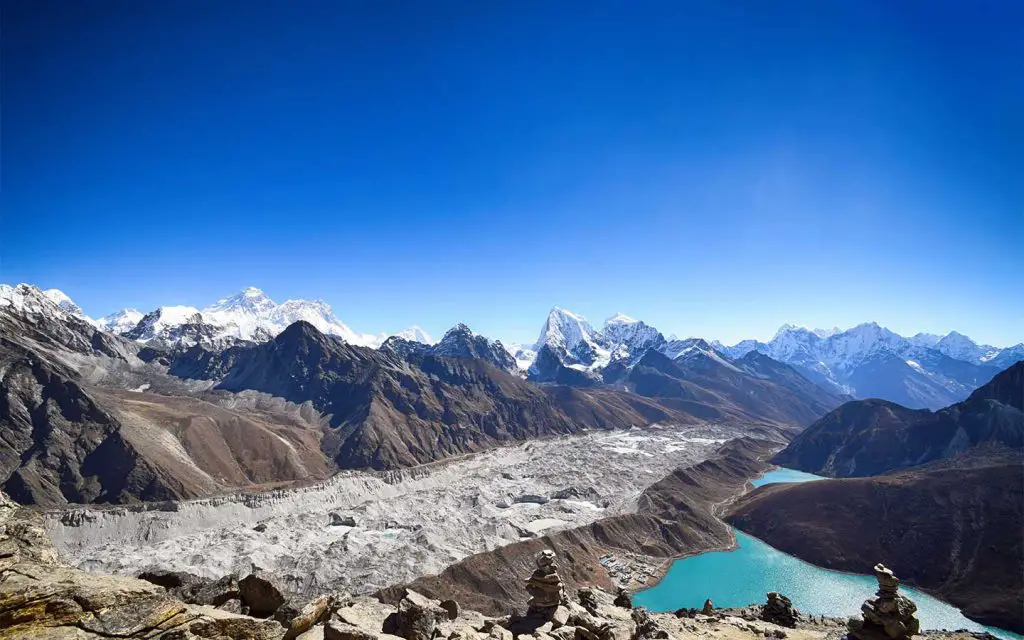
Trekking duration: 3 to 4 hours
Trekking distance: 8.9 km
Hike duration: 4 hours
Overnight at Gokyo
After a wild and adventurous trek till now, you will visit another major highlight of this trip today. The hike to Gokyo is strenuous and physically demanding, so be prepared for more fun and excitement.
The trek begins by running over a glacier and making a steep ascent along the narrow valley through the Ngozumpa glacier. You then venture through the rugged trails for a couple of hours and reach the first Gokyo Lake.
The fantastic view of the glistening mountain and rocky cliffs around the lake will mesmerize you. But the trip is not over so, follow the flat path along the Dudh Koshi River until you reach Gokyo.
You have your lunch here and prepare to visit the fifth lake after fueling your body. The trails lead you through rugged terrains while doing slight climbs until you arrive at Fifth lake.
The pristine lake looks stunning but the glorious mountains on the backdrop add more beauty to the lake. You spend some time exploring around the lake and head back to the village.
Gokyo is the highest human settlement in the Everest region. This village lies below Gokyo Ri and has several inns, guesthouses, and lodges.
Day 12: Early morning climb up to Gokyo Ri (5357 m/ 17575 ft) then trek down to Dole (4200 m/ 13779 ft)
Hike duration: 2 to 3 hours
Trekking duration: 5 hours
Overnight at Dole
Today you wake up before dawn and prepare yourself to climb Gokyo Ri. You start by making a steep climb through the southern slope of Ngozumpa and Tajun lake.
The trails keep getting steeper and rugged with a rise in elevation, so walk steady and slow. After walking for a few hours, you reach the summit in time to view the sunrise.
The view of the sun slowly rising in between the mountains will be a memory of a lifetime. The peaks of Lhotse, Makalu, Cho Oyu, Nuptse, and others look beautiful as the sun rays hit them.
After a wonderful time, you trek down to Gokyo and prepare yourself to head to Dole after a warm breakfast. You follow the trail that leads to the fifth lake then through the Ngozumpa glacier.
After walking for a mile or more, the glimpse of Gokyo valley begins to fade. Slowly moving ahead, you pass several chortens, Sherpa settlement, and reach Dole.
Day 13: Trek to Namche bazaar
Trekking Duration: 6 to 7 hours
Overnight at Namche Bazaar
You leave Dole and descend the sloping trail to flat terrain. From there, you walk gently along the routes and cross over a suspension bridge to reach Kyanjuma. Then you trek through the alpine forest of rhododendron and pines and head towards the valley.
The descent to Namche is relaxing as you travel while viewing majestic mountains, lush meadows, and green hills. After several ups and downs, you make a steep downhill walk along with the monasteries and reach your destination.
Day 14: Trek down to Lukla
Trekking Duration: 7 to 8 hours
Overnight at Lukla
Today will be the last day you trek in the trails of the Khumbu region. You begin with a steep descent and continue to walk alongside Dudh Koshi river while crossing several suspension bridges.
The trails also take you through dense forests of pine, oaks, rhododendron, and more. You will mainly be retracing your steps back from Namche to Lukla.
Day 15: Fly back to Kathmandu (1400 m) and transfer to the hotel
It is the final day in your Everest Base Camp Cho La Pass Gokyo Trek itinerary. You catch the early flight to Kathmandu from Lukla airport and bid farewell to the region.
You fly back viewing beautiful sceneries of nature. After landing, the guide will transfer you to the hotel and end your Everest Base Camp and Gokyo Cho La Pass trek. We at TrekEBC hope your time with us was memorable and exciting.
See also:
- Distance From Base Camp to Everest summit
- How Tall is Mount Everest?
- How Cold Is It On Mount Everest?
Final Words
Overall, Everest Base Camp Cho La Pass Gokyo Trek is an adventurous trek in the Khumbu region. It offers stunning views of the Himalayan giants, pristine lake, and breathtaking landscapes. So, join TrekEBC for this heavenly pleasure and memories that are worth a lifetime.
